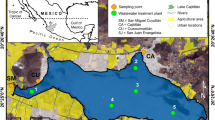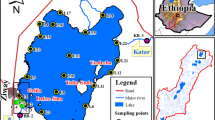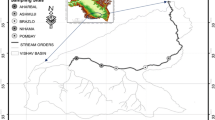Abstract
This research explains the background processes responsible for the spatial distribution of hydrochemical properties of the picturesque eutrophic Himalayan Lake, Dal, located in Kashmir valley, India. Univariate and multivariate statistical analyses were used to understand the spatiotemporal variability of 18 hydrochemical parameters comprising of 12,960 observations collected from 30 sampling sites well distributed within the lake at a grid spacing of 1 km2 from March 2014 to February 2016. Hierarchical cluster analysis (HCA) grouped all the sampled data into three clusters based on the hydrochemical similarities, Discriminant analysis also revealed the same clusters and patterns in the data, validating the results of HCA. Wilk’s λ quotient distribution revealed the contribution of ions, nutrients, secchi disk transparency, dissolved oxygen and pH in the formation of clusters. The results are in consonance with the Principal Component Analysis of the whole lake data and individual clusters, which showed that the variance is maximally explained by the ionic component (46.82%) followed by dissolved oxygen and pH (9.36%), nitrates and phosphates (7.33%) and Secchi disk transparency (5.98%). Spatial variability of the hydrochemistry of the lake is due to the variations in water depth, lake water dynamics, flushing rate of water, organic matter decomposition, and anthropogenic pressures within and around the Dal lake ecosystem. Overall, the water quality of the lake is unfit for drinking due to the presence of coliform bacteria in the lake waters.









Similar content being viewed by others
References
Afifi A, Clark VA, May S, Raton B (2004) Computer-aided multivariate analysis, 4th edn. Chapman & Hall, London
American Public Health Association (APHA) (2005) Standard methods for the examination of water and waste water. 21st edn. Washington, DC
Amin A, Fazal S, Mujtaba A, Singh SK (2014) Effects of land transformation on water quality of Dal lake, Srinagar, India. J Indian Soc Remote Sens 42(1):119–128
Anttila S, Kairesalo T, Pellikka P (2008) A feasible method to assess inaccuracy caused by patchiness in water quality monitoring. Environ Monit Assess 142:11–22. https://doi.org/10.1007/s10661-007-9904-y
Badar B, Romshoo SA (2007) Modelling the non-point source pollution load in an urban watershed using remote sensing and GIS: a case study of Dal lake. J Himal Ecol Sustain Dev 2(1):21–30
Badar B, Romshoo SA, Khan MA (2013a) Integrating biophysical and socio-economic information for prioritizing watersheds in the Kashmir Himalayan lake: a remote sensing and GIS approach. Environ Monit Assess 185(8):6419–6445
Badar B, Romshoo SA, Khan MA (2013b) Modeling the catchment hydrological response in a Himalayan lake as a function of changing land system. Earth Syst Sci 112(2):433–449
Bagnolus F, Meher-Homji VM (1959) Bio-climatic types of south East Asia. Travaux de la Section Scientific at Technique Institut Francis de Pondicherry, p 227
Brown TC, Froemke P (2012) Nationwide assessment of nonpoint source threats to water quality. BioScience 62(2):136–146
Bureau of Indian Standards (2012) Indian Standard drinking water specifications. BIS.10500:2012
Carpenter SR, Caraco NF, Correll DL, Howarth RW, Sharpley AN, Smith VH (1998) Nonpoint pollution of surface waters with phosphorus and nitrogen. Ecol Appl 8(3):559–568
Chang NB (2005) Sustainable water resources management under uncertainty. Stoch Environ Res Risk Assess 19(2):97–98
Chen Y, Zhao K, Wu Y, Gao S, Cao W, Bo Y, Shang Z, Wu J, Zhou F (2016) Spatio-temporal patterns and source identification of water pollution in lake Taihu (China). Water 8(3):86
Datta NK (1983) Geology, evolution and hydrocarbon prospects of Kashmir valley. Pet Asia J, 176–177
De Ceballos BSO, Koning A, De Olivera JF (1998) Dam reservoir eutrophication: a simplified technique for a fast diagnosis of an environmental degradation. Water Res 32(11):3477–3483
Duan W, He B, Nover D, Yang G, Chen W, Meng H, Zou S, Liu C (2016) Water quality assessment and pollution source identification of the eastern Poyang Lake Basin using multivariate statistical methods. Sustainability 8(2):133
Dudgeon D, Arthington AH, Gessner MO, Kawabata Z, Knowler DJ, Leveque C, Naiman RJ, Prieur-Richard A, Soto D, Stiassny MLJ, Sullivan CA (2006) Freshwater biodiversity: importance, threats, status and conservation challenges. Biol Rev 81:163–182
Elhatip H, Hinis MA, Gulgahar N (2007) Evaluation of the water quality at Tahtali dam watershed in Izmir, Turkey by means of statistical methodology. Stoch Environ Res Risk Assess 22(3):391–400
Hamid A, Bhat SA, Bhat SU, Jehangir A (2016) Environmetric techniques in water quality assessment and monitoring: a case study. Environ Earth Sci 75:321
Hassan Z, Shah JA, Kanth TA, Pandit AK (2015) Influence of land use/land cover on the water chemistry of Wular Lake in Kashmir Himalaya (India). Ecol Process 4(1):1–11
Hatvani IG, Kovács J, Kovácsne SI, Jakusch P, Korponai J (2011) Analysis of lomg term water quality changes in the Kis-Balaton Water Protection System with time series, cluster analysis and Wilk’s lambda distribution. Ecol Eng 37(4):629–635
Hatvani IG, Clement A, Kovács J, Kovács SI, Korponai J (2014) Assessing water quality data: the relationship between the water quality amelioration of Lake Balaton and the construction of its mitigation wetland. J Great Lakes Res 40:115–125
Hector RA, Manuel CC, Rey MQ, Ruben AST, Adan PM (2012) An overall water quality index (WQI) for a man-made aquatic reservoir in Mexico. Int J Environ Res Public Health 9:1687–1698
Hedger RD, Atkinson PM, Malthus TJ (2001) Optimizing sampling strategies for estimating mean water quality in lakes using geostatistical techniques with remote sensing. Lake Reserv Res Manag 6:279–288
Helena B, Pardo R, Vega M, Barrado E, Fernandez JM, Fernandez L (2000) Temporal evolution of ground water composition in an alluvial aquifer (Pisuerga River, Spain) by principal component analysis. Water Res 34:807–816
Horton R (1965) An index number system for rating water quality. J Water Pollut Control Fed 37:300–306
Huang F, Wang X, Lou L, Zhou Z, Wu J (2010) Spatial variation and source apportionment of water pollution in Qiantang River (China) using statistical techniques. Water Res 44(5):1562–1572
Jan D (2013b) Monitoring of sewage treatment plants around the Dal Lake for waste water treatment. Ph.D. thesis, University of Kashmir
Jan D, Pandit AK, Kamili AN (2013) Efficiency evaluation of three fluidised aerobic bioreactor based sewage treatment plants in Kashmir Valley. Afr J Biotechnol 12(17):2224–2233
Jarvie HP, Whitton BA, Neal C (1998) Nitrogen and phosphorus in east coast British rivers: speciation, sources and biological significance. Sci Total Environ 210–211:79–109
Jassby AD, Cole BE, Cloern JE (1997) The design of sampling transects for characterizing water quality in Estuaries. Estuar Coast Shelf Sci 45:285–302
Javaid M, Ahmad A (2015) Evaluating the morphometric and hydrological characteristics of Dal lake using remote sensing and GIS. J Himal Ecol Sustain Dev 10:49–56
Jeppesen E, Jensen JP, Sondergaard M, Lauridsen T, Pedersen LJ, Jensen L (1997) Top-down control in freshwater lakes: the role of nutrient state, submerged macrophytes and water depth. Hydrobiologia 342(343):151–164
Johnson RA, Wichern DW (1992) Applied multivariate statistical analysis, 3rd edn. Prentice Hall, Englewood Cliffs
Juahir H, Zain SM, Yusoff MK, Hanidza TIT, Armi ASM, Toriman ME, Mokhtar M (2011) Spatial water quality assessment of Langat River Basin (Malaysia) using environmetric techniques. Environ Monit Assess 173(1–4):625–641
Kawoosa BJ (2017) Dal Lake—The myth, perceptions and the realities. Jklda.org
Ketskeméty L, Izsó L (2005) Introduction into the SPSS system (Bevezetés az SPSS programrendszerbe). ELTE Eötvös Kiadó, Budapest
Zutshi DP, Khan MA (1978) On lake typology of Kashmir. Environmental physiology and ecology of plants, pp 465–472
Khanday SA, Yousuf AR, Reshi ZA, Rashid I, Jehangir A, Romshoo SA (2016) Management of Nymphoides peltatum using water level fluctuations in fresh water lakes of Kashmir Himalaya. Limnology. https://doi.org/10.1007/s10201-016-0503-x
Kolovos A, Christakos G, Serre ML, Miller CT (2002) Computational BME solution of a stochastic advection reaction equation in the light of site-specific information. Water Resour Res 38(12):1318–1334
Kumar M, Puri A (2012) A review of permissible limits of drinking water. Indian J Occup Environ Med 16:40–44
Lambrakis N, Antonakos A, Panagopoulos G (2004) The use of multicomponent statistical analysis in hydrogeological environmental research. Water Res 38:1862–1872
Levin SA (1992) The problem of pattern and scale in ecology. Ecology 73:1943–1967
Liu CW, Lin KH, Kuo YM (2003) Application of factor analysis in the assessment of ground water quality in a black foot disease area in Taiwan. Sci Total Environ 31(3):77–89
Magyar N, Hatvani IG, Székely IK, Herzig A, Dinka M, Kovács J (2013) Application of multivariate statistical methods in determining spatial changes in water quality in the Austrian part of Neusiedler See. Ecol Eng 85:82–92
Masoodi S (2017) Water quality assessment of Dal Lake, Kashmir, J&K. Int J Eng Technol Sci Res 4(5):375–383
Masoodi A, Sengupta A, Khan FA, Sharma GP (2013) Predicting the spread of alligator weed (Alternanthera philoxeroides) in Wular Lake, India: a mathematical approach. Ecol Model 263:119–125
Mavukkandy MO, Karmakar S, Harikumar PS (2014) Assessment and rationalization of water quality monitoring network: a multivariate statistical approach to the Kabbini River (India). Environ Sci Pollut Res 21:10045–10066. https://doi.org/10.1007/s11356-014-3000-y
McKenna J (2003) An enhanced cluster analysis program with bootstrap significance testing for ecological community analysis. Environ Model Softw 18:205–220
Mei K, Liao L, Zhu Y, Lu P, Wang Z, Dahlgren RA, Zhang M (2014) Evaluation of spatial–temporal variations and trends in surface water quality across a rural suburban–urban interface. Environ Sci Pollut Res 21:8036–8051. https://doi.org/10.1007/s11356-014-2716-z
Momen B, Zehr GP, Boylen CW, Sutherland JW (1999) Determinants of summer nitrate concentration in a set of Adirondack Lakes, New York. Water Air Soil Pollut 111:19–28
Mushtaq B, Raina R, Yaseen T, Wanganeo A, Yousuf AR (2013) Variations in the physico-chemical properties of Dal Lake, Srinagar, Kashmir. Afr J Environ Sci Technol 7(7):624–633
Najar IA, Khan AB (2012) Assessment of water quality and identification of pollution sources of three lakes in Kashmir, India, using multivariate analysis. Environ Earth Sci 66(8):2367–2378
Nelson NM, Loomis JB, Paul M, Jakus PM, Kealy MJ, Stackelburg N, Ostermiller J (2015) Linking ecological data and economics to estimate the total economic value of improving water quality by reducing nutrients. Ecol Econ 118:1–9
Norusis MJ (1993) SPSS for Windows Professional Statistics Release 6.0. Prentice Hall, Englewood Cliffs
O’Reilly CM, Alin SR, Plisnier PD, Cohen AS, Mckee BA (2003) Climate change decreases aquatic ecosystem productivity of Lake Tanganyika, Africa. Nature 424:766–768
Panda UC, Sundaray SK, Rath P, Nayak BB, Bhatta D (2006) Application of factor and cluster analysis for characterization of river and estuarine water systems—a case study: Mahanadi River (India). J Hydrol 331:434–445
Pandit AK (1988) Threats to Kashmir wetlands and their wildlife resources. Environ Conserv 15(03):266–268
Papatheodorou G, Demopoulou G, Lambrakis N (2006) A long-term study of temporal hydrochemical data in a shallow lake using multivariate statistical techniques. Ecol Model 193:759–776
Rajaram T, Das A (2008) Water pollution by industrial effluents in India: discharge scenarios and case for participatory ecosystem specific local regulation. Futures 40(1):56–69
Rashid I, Farooq M, Muslim M, Romshoo SA (2013) Assessing the impact of anthropogenic activities on Manasbal Lake in Kashmir Himalayas. Int J Environ Sci 3(6):2052–2063
Rashid I, Romshoo SA, Amin M, Khanday SA, Chauhan P (2017) Linking human-biophysical interactions with the trophic status of Dal lake. Limnol Ecol Manag Inland Waters 62:84–96
Rast W, Holland M (1998) Eutrophication of lakes and reservoirs: a framework for making management decisions. Ambio 17(1):2–12
Ravikumar P, Somashekar RK, Mehmood MA (2013) Water quality index to determine the surface water quality of Sankey tank and Mallathahalli lake, Bangalore urban district, Karnataka, India. Appl Water Sci 3:247–261
Romshoo SA, Muslim M (2011) Geospatial modeling for assessing the nutrient load of a Himalayan lake. Environ Earth Sci 64(5):1269–1282
Sahu P, Sikdar PK (2008) Hydrochemical framework of the aquifer in and around East Kolkata Wetlands, West Bengal, India. Environ Geol 55(4):823–835
Saleem S, Kamili AN, Kakru DK, Bandh SA (2013) Water quality assessment of Dal Lake, Kashmir using the coliforms as indicator bacteria. J New Biol Rep 2(1):30–35
Saleem M, Jeelani G, Shah RA (2015) Hydrogeochemistry of Dal Lake and the potential for present, future management by using facies, ionic ratios, and statistical analysis. Environ Earth Sci 74(4):3301–3313
Sanchez E, Colmenarejo MF, Vicente J, Rubio A, Garcia MG, Travieso L, Borja R (2007) Use of the water quality index and dissolved oxygen deficit as simple indicators of watersheds pollution. Ecol Ind 7(2):315–328
Sargaonkar A (2003) Deshpande V (2003) Development of an overall index of pollution for surface water based on a general classification scheme in Indian context. Environ Monit Assess 89:43–67
Scheffer M (1998) The ecology of shallow lakes. Chapman & Hall, London
Schriver P, Bogestrand J, Jeppesen E, Sondergaard M (1995) Impact of submerged macrophytes on fish–zooplankton–phytoplankton interactions: large scale enclosure experiments in a shallow eutrophic lake. Freshw Biol 33:255–270
Shar AH, Kazi Y, Zardari M, Soomro IH (2008) Enumeration of total and fecal coliform bacteria in drinking water of Khairpur Sindh. Pak J Med Res 47:18–21
Shrestha S, Kazama F (2007) Assessment of surface water quality using multivariate statistical techniques: a case study of the Fuji river basin. Jpn Environ Model Softw 22(4):464–475
Sibson R (1981) A brief description of natural neighbour interpolation. Interpret Multivar Data 21:21–36
Simeonov V, Stratis JA, Samara C, Zacharadis G, Voutsa D, Anthemidis A, Sofoniou M, Kouimitzis T (2003) Assessment of the surface water quality in Northern Greece. Water Res 37(17):4119–4124
Singh KP, Malik A, Mohan D, Sinha S (2004) Multivariate statistical techniques for the evaluation of spatial and temporal variations in water quality of Gomti River (India): a case study. Water Res 38(18):3980–3992
Singh KP, Malik A, Sinha S (2005) Water quality assessment and apportionment of pollution sources of Gomti River (India) using multivariate statistical techniques: a case study. Anal Chem Acta 538:355–374
Smith VH (2003) Eutrophication of freshwater and coastal marine ecosystems—a global problem. Environ Sci Pollut Res 10:126–139
Solim SU, Wanganeo A (2008) Excessive phosphorus loading to Dal Lake, India: implications for managing shallow eutrophic lakes in urbanized watersheds. Int Rev Hydrobiol 93(2):148–166
Steinhart CE, Schierow LJ, Sonzogni WC (1982) Environmental quality index for the Great Lakes. Water Resour Bull 18(6):1025–1031
Trisal CL (1987) Ecology and conservation of Dal lake, Kashmir. Int J Water Resour Dev 3(1):44–54
Turner W, Spector S, Gardiner N, Fladeland M, Sterling E, Steininger M (2003) Remote sensing for biodiversity science and conservation. Trends Ecol Evol 18:306–314
Underwood AJ, Chapman MG, Connell SD (2000) Observations in ecology: you can’t make progress on processes without understanding the patterns. J Exp Mar Biol Ecol 250:97–115
Varadan VKS (1977) Geology and mineral resources of the state of India part X Jammu and Kashmir State. Geol Surv India 30:1–71
Varol S, Davraz A (2015) Evaluation of the groundwater quality with WQI (water quality index) and multivariate analysis: a case study of the Tefenni plain (Burdur/Turkey). Environ Earth Sci 73:1725–1744
Varol M, Sen B (2009) Assessment of surface water quality using multivariate statistical techniques: a case study of Behrimaz Stream, Turkey. Environ Monit Assess 159:543–553
Varol M, Gökot B, Bekleyen A, Sen B (2012) Spatial and temporal variations in surface water quality of the dam reservoirs in the Tigris River basin, Turkey. Catena 92:11–21
Vasanthavigar M, Srinivasamoorthy K, Vijayaragavan K, Rajiv Ganthi R, Chidambaram S, Anandhan P, Manivannan R, Vasudevan S (2010) Application of water quality index for groundwater quality assessment: Thirumanimuttar sub-basin, Tamil Nadu, India. Environ Monit Assess 171:595–609
Vega M, Pardo R, Barrado E, Deban L (1998) Assessment of seasonal and polluting effects on the quality of river water by exploratory data analysis. Water Res 32(12):3581–3592
Vorosmarty CJ, Green P, Salisbury J, Lammers RB (2000) Global water resources: vulnerability from climate change and population growth. Science 289:284–288
Walsh PJ, Milon JW (2016) Nutrient standards, water quality indicators, and economic benefits from water quality regulations. Environ Resour Econ 64:643–661
Wang HY (2002) Assessment and prediction of overall environmental quality of Zhuzhou City, Hunan Province. China J Environ Manag 66(3):329–340
Ward JH Jr (1963) Hierarchical grouping to optimize an objective function. J Am Stat Assoc 58(301):236–244
Wetzel RG (1975) Limnology: Philadelphia. WB Saunders Company 3
Wilks SS (1932) Certain generalizations in the analysis of variance. Biometrika 24:471–494
Yang Y, Zhou F, Guo H, Sheng H, Liu H, Dao X, He C (2010) Analysis of spatial and temporal water pollution patterns in Lake Dianchi using multivariate statistical methods. Environ Monit Assess 170:407–416
Yidana SM, Yidana A (2010) Assessing water quality using water quality index and multivariate analysis. Environ Earth Sci 59(7):1461–1473
Zhang SR, Lu XX, Higgitt DL, Chen CTA, Sun HG, Han JT (2007) Water chemistry of the Zhujiang (Pearl River): natural processes and anthropogenic influences. J Geophys Res 112(F1):F01011. https://doi.org/10.1029/2006JF000493
Zhou F, Liu Y, Guo H (2007) Application of multivariate statistical methods to water quality assessment of the watercourses in northern new territories. Hong Kong Environ Monit Assess 132(1–3):1–13
Zutshi DP, Subla BA, Khan MA, Wanganeo A (1980) Comparative limnology of nine lakes of Jammu and Kashmir Himalayas. Hydrobiologia 72(1–2):101–112
Acknowledgements
This research work has been accomplished under a research grant provided by the Space Application Centre (SAC), Indian Space Research Organization (ISRO), Ahmadabad, India for the project titled “Bio-optical characterization of Optically Complex Dal Waters”. The authors are thankful to the Lakes and waterways development authority (LAWDA) for providing the coliform bacterial data used in this study.
Author information
Authors and Affiliations
Corresponding author
Rights and permissions
About this article
Cite this article
Khanday, S.A., Romshoo, S.A., Jehangir, A. et al. Environmetric and GIS techniques for hydrochemical characterization of the Dal lake, Kashmir Himalaya, India. Stoch Environ Res Risk Assess 32, 3151–3168 (2018). https://doi.org/10.1007/s00477-018-1581-6
Published:
Issue Date:
DOI: https://doi.org/10.1007/s00477-018-1581-6




